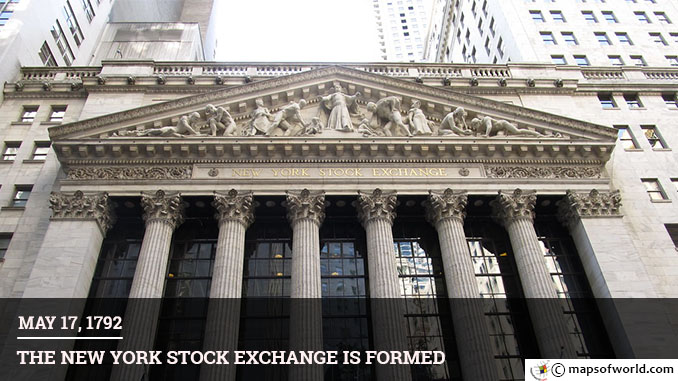The New York Stock Exchange (NYSE), also commonly called the “Big Board”, is the world’s largest stock exchange in terms of its market capitalization which is currently worth over 14 trillion dollars. The stock exchange came into being following an agreement among New York traders entered into on May 17, 1792. The current offices of the NYSE are located at 11 Wall Street, Lower Manhattan, New York City. The history of the world’s largest stock exchange was a very humble one. On May 17, 1792, a group of 24 stock brokers from New York signed the Buttonwood Agreement, named after the buttonwood (American Sycamore) tree under which it was signed. The tree located outside 68 Wall Street, New York became the setting for an agreement under the terms of which the brokers agreed to trade only with each other. The commission agreed was 0.25 percent; this meant that $2.5 would be charged on a $1000 bond. “We the Subscribers, Brokers for the Purchase and Sale of the Public Stock, do hereby solemnly promise and pledge ourselves to each other, that we will not buy or sell from this day for any person whatsoever, any kind of Public Stock, at a less rate than one quarter percent Commission on the Specie value and that we will give preference to each other in our Negotiations. In Testimony whereof we have set our hands this 17th day of May at New York, 1792” – Buttonwood Agreement The earliest office of the New York Stock Exchange was a room rented at 40 Wall Street for $200 per month. The first listed company to trade at the NYSE was the Bank of New York. By the 20th century, the New York Stock Exchange became one of the primary exchanges for important companies to list and trade in. The Buttonwood Agreement was initially an attempt to keep the competition at bay. Apart from exclusivity, the member brokers agreed that the stocks enlisted on the NYSE would not be traded in any other exchanges. Till 1930, the New York Stock Exchange was almost unregulated. For a few following decades, the exchange became a self-regulatory organization which monitored its own trading activities under the cursory supervision of the Securities and Exchange Commission. By the 1960s, however, the monopoly of the NYSE brokers began to break. With the introduction of computers and with emerging competition, new brokers started to trade in the shares listed at the Big Board for less commission. The government soon stepped in and banned fixed commissions. The exchange made a move to liberalize trading and started to allow trading of shares listed on NYSE from all locations. While it lost exclusivity of trade, the NYSE stayed a dominant marketplace and reference index. The evolution of the financial world was rapid through the next decade. With the introduction of options on stocks and commodity trading, the NYSE failed to explore the vast potential that presented itself and soon emerging exchanges such as Chicago gathered much clout in the world of trading. Commodity, currency values, interest rates did well at Chicago. With the Internet and technology boom, more exchanges started to move to computerization, the NYSE struggled to keep with competition. In 2007, the Financial Industry Regulatory Authority (FINRA) was formed by a consolidation of the regulations enforcement and supervisory unit of the New York Stock Exchange, called the NYSE Regulation, and NASD. The FINRA started to oversee NYSE operations in 2007. In 2006, NYSE ceased to be owned by its members and went public; it merged with Archipelago Holdings to form the NYSE Group, Inc. in April 2006. In 2007, the NYSE Group, Inc. further announced its merger with Euronext N.V. to form the NYSE Euronext – the first global equities exchange. In December 2012, Intercontinental Exchange (ICE) signed a deal agreeing to buy NYSE Euronext in a $8.2 billion deal, making it one of the largest derivatives markets operators in the world. ICE plans to keep the Wall Street office but also plans to compartmentalize the group’s European business. The takeover has made ICE the third largest operator of future exchanges in the world. Also on this day: 1814 – The Constitution of Norway is signed by the Norwegian Constituent Assembly. 1943 – Operation Chastise destroys Ruhr Valley dams. 1954 – Brown v. Board of Education is decided, handing a victory to the civil rights movement. 1973 – The US Senate Watergate Committee begins hearings. 2004 – Massachusetts becomes the first US state to legalize same-sex marriage.
May 17 1792 – The New York Stock Exchange is Formed
The New York Stock Exchange (NYSE), also commonly called the “Big Board”, is the world’s largest stock exchange in terms of its market capitalization which is currently worth over 14…
360
